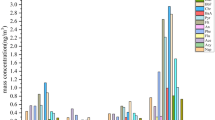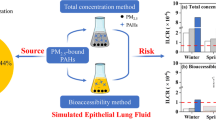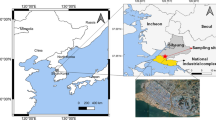Abstract
In previous studies, inhalation cancer risk was estimated using conventional risk assessment method, which was normally based on compound-specific analysis, and cannot provide substantial data for source-specific particulate matter concentrations and pollution control. In the present study, we applied an integrated risk analysis method, which was a synthetic combination of source apportionment receptor model and risk assessment method, to estimate cancer risks associated to individual PAHs coming from specific sources. Personal exposure particulate matter samples referring to an elderly panel were collected in a community of Tianjin, Northern China, in 2009, and 12 PAH compounds were measured using GC-MS. Positive matrix factorization (PMF) was used to extract the potential sources and quantify the source contributions to the PAH mixture. Then, the lung cancer risk of each modeled source was estimated by summing up the cancer risks of all measured PAH species according to the extracted source profile. The final results indicated that the overall cancer risk was 1.12 × 10−5, with the largest contribution from gasoline vehicle emission (44.1%). Unlike other risk estimation studies, this study was successful in combining risk analysis and source apportionment approaches, which allow estimating the potential risk of all source types and provided suitable information to select prior control strategies and mitigate the main air pollution sources that contributing to health risks.



Similar content being viewed by others
References
Amador-Munoz O et al (2010) Solvent extracted organic matter and polycyclic aromatic hydrocarbons distributed in size-segregated airborne particles in a zone of Mexico City: seasonal behavior and human exposure. Atmos Environ 44:122–130. https://doi.org/10.1016/j.atmosenv.2009.07.012
Andreou G, Rapsomanikis S (2009) Polycyclic aromatic hydrocarbons and their oxygenated derivatives in the urban atmosphere of Athens. J Hazard Mater 172:363–373. https://doi.org/10.1016/j.jhazmat.2009.07.023
Aydin YM, Kara M, Dumanoglu Y, Odabasi M, Elbir T (2014) Source apportionment of polycyclic aromatic hydrocarbons (PAHs) and polychlorinated biphenyls (PCBs) in ambient air of an industrial region in Turkey. Atmos Environ 97:271–285. https://doi.org/10.1016/j.atmosenv.2014.08.032
Boström C-E et al (2002) Cancer risk assessment, indicators, and guidelines for polycyclic aromatic hydrocarbons in the ambient air. Environ Health Perspect 110:451
Brinkman G, Vance G, Hannigan MP, Milford JB (2006) Use of synthetic data to evaluate positive matrix factorization as a source apportionment tool for PM2.5 exposure data. Environ Sci Technol 40:1892–1901. https://doi.org/10.1021/es051712y
Callen MS, Lopez JM, Mastral AM (2012) Apportionment of the airborne PM10 in Spain. Episodes of potential negative impact for human health. J Environ Monit 14:1210–1219. https://doi.org/10.1039/c2em10802j
Cao Q, Wang H, Chen G (2011) Source apportionment of PAHs using two mathematical models for mangrove sediments in Shantou coastal zone, China. Estuar Coasts 34:950–960. https://doi.org/10.1007/s12237-011-9397-3
Crilley LR et al (2017) Source apportionment of fine and coarse particles at a roadside and urban background site in London during the 2012 summer ClearfLo campaign. Environ Pollut 220(Part B):766–778. https://doi.org/10.1016/j.envpol.2016.06.002
Cristale J, Silva FS, Zocolo GJ, Marchi MRR (2012) Influence of sugarcane burning on indoor/outdoor PAH air pollution in Brazil. Environ Pollut 169:210–216. https://doi.org/10.1016/j.envpol.2012.03.045
Du X, Dong S (2013) Tianjin Statistical Yearbook. China Statistics Press, Beijing
Duval M, Friedlander S (1981) Source resolution of polycyclic aromatic hydrocarbons in the LosAngeles atmosphere application of a CMB with first-order decay US EPA Report EPA-600/2-81-161. US Government Printing Office, Washington, DC
Feng Y et al (2014) A community study of the effect of polycyclic aromatic hydrocarbon metabolites on heart rate variability based on the Framingham risk score. Occup Environ Med 71:338–345. https://doi.org/10.1136/oemed-2013-101884
Gu Y-G, Li H-B, Lu H-B (2017) Polycyclic aromatic hydrocarbons (PAHs) in surface sediments from the largest deep plateau lake in China: occurrence, sources and biological risk. Ecol Eng 101:179–184. https://doi.org/10.1016/j.ecoleng.2017.02.007
Han B et al. (2014) Characterizations, relationship, and potential sources of outdoor and indoor particulate matter bound polycyclic aromatic hydrocarbons (PAHs) in a community of Tianjin, Northern China Indoor Air Accepted https://doi.org/10.1111/ina.12145
Hopke PK, Ramadan Z, Paatero P, Norris GA, Landis MS, Williams RW, Lewis CW (2003) Receptor modeling of ambient and personal exposure samples: 1998 Baltimore Particulate Matter Epidemiology-Exposure Study. Atmos Environ 37:3289–3302. https://doi.org/10.1016/S1352-2310(03)00331-5
Hu Y, Bai Z, Zhang L, Wang X, Zhang L, Yu Q, Zhu T (2007) Health risk assessment for traffic policemen exposed to polycyclic aromatic hydrocarbons (PAHs) in Tianjin, China. Sci Total Environ 382:240–250. https://doi.org/10.1016/j.scitotenv.2007.04.038
Jang E, Alam MS, Harrison RM (2013) Source apportionment of polycyclic aromatic hydrocarbons in urban air using positive matrix factorization and spatial distribution analysis. Atmos Environ 79:271–285. https://doi.org/10.1016/j.atmosenv.2013.06.056
Jia Y, Stone D, Wang W, Schrlau J, Tao S, Simonich SLM (2011) Estimated reduction in cancer risk due to PAH exposures if source control measures during the 2008 Beijing Olympics were sustained. Environ Health Perspect 119:815
Khalili NR, Scheff PA, Holsen TM (1995) PAH source fingerprints for coke ovens, diesel and, gasoline engines, highway tunnels, and wood combustion emissions. Atmos Environ 29:533–542. https://doi.org/10.1016/1352-2310(94)00275-P
Kuo C-Y, Yang Y-H, Chao M-R, Hu C-W (2008) The exposure of temple workers to polycyclic aromatic hydrocarbons. Sci Total Environ 401:44–50. https://doi.org/10.1016/j.scitotenv.2008.04.018
Larson T, Gould T, Simpson C, Liu LJS, Claiborn C, Lewtas J (2004) Source apportionment of indoor, outdoor, and personal PM2.5 in Seattle, Washington, using positive matrix factorization. J Air Waste Manage Assoc 54:1175–1187. https://doi.org/10.1080/10473289.2004.10470976
Li PH et al (2013) Health risk assessment for vehicle inspection workers exposed to airborne polycyclic aromatic hydrocarbons (PAHs) in their work place. Environ Sci: Processes Impacts 15:623–632. https://doi.org/10.1039/c2em30708a
Li WF, Peng Y, Shi JW, Qiu WG, Wang J, Bai ZP (2011) Particulate polycyclic aromatic hydrocarbons in the urban Northeast Region of China: profiles, distributions and sources. Atmos Environ 45:7664–7671. https://doi.org/10.1016/j.atmosenv.2011.04.004
Liu M, Feng J, Hu P, Tan L, Zhang X, Sun J (2016) Spatial-temporal distributions, sources of polycyclic aromatic hydrocarbons (PAHs) in surface water and suspended particular matter from the upper reach of Huaihe River, China. Ecol Eng 95:143–151. https://doi.org/10.1016/j.ecoleng.2016.06.045
Manoli E, Kouras A, Samara C (2004) Profile analysis of ambient and source emitted particle-bound polycyclic aromatic hydrocarbons from three sites in northern Greece. Chemosphere 56:867–878. https://doi.org/10.1016/j.chemosphere.2004.03.013
Marr LC et al (2006) Sources and transformations of particle-bound polycyclic aromatic hydrocarbons in Mexico City. Atmos Chem Phys 6:1733–1745. https://doi.org/10.5194/acp-6-1733-2006
Minguillón MC et al (2012) Source apportionment of indoor, outdoor and personal PM2.5 exposure of pregnant women in Barcelona, Spain. Atmos Environ 59:426–436. https://doi.org/10.1016/j.atmosenv.2012.04.052
Mukerjee S, Biswas P (1992) A concept of risk apportionment of air emission sources for risk reduction considerations. Environ Technol 13:635–646. https://doi.org/10.1080/09593339209385193
Nisbet IC, LaGoy PK (1992) Toxic equivalency factors (TEFs) for polycyclic aromatic hydrocarbons (PAHs). Regul Toxicol Pharmacol 16:290–300. https://doi.org/10.1016/0273-2300(92)90009-x
Norris G, Duvall R, Brown S, Bai S (2014) EPA positive matrix factorization (pmf) 5.0 fundamentals and user guide prepared for the US Environmental Protection Agency Office of Research and Development. Washington, DC Inc, Petaluma
Norris G, Vedantham R, Duvall R, Brown S, Prouty J, Prouty J (2011) EPA positive matrix factorization 4.2 fundamentals and user guide. USEPA Office of Research and Development, Washington, DC
Norris G et al (2009) Guidance document for PMF applications with the Multilinear Engine. U.S. Environmental Protection Agency, Washington, DC
Paatero P (1997) Least squares formulation of robust non-negative factor analysis. Chemom Intell Lab Syst 37:23–35. https://doi.org/10.1016/S0169-7439(96)00044-5
Paatero P, Hopke PK, Song X-H, Ramadan Z (2002) Understanding and controlling rotations in factor analytic models. Chemom Intell Lab Syst 60:253–264. https://doi.org/10.1016/S0169-7439(01)00200-3
Paatero P, Tapper U (1994) Positive matrix factorization: a non-negative factor model with optimal utilization of error estimates of data values. Environmetrics 5:111–126. https://doi.org/10.1002/env.3170050203
Park D, Oh M, Yoon Y, Park E, Lee K (2012) Source identification of PM10 pollution in subway passenger cabins using positive matrix factorization. Atmos Environ 49:180–185. https://doi.org/10.1016/j.atmosenv.2011.11.064
Rajput N, Lakhani A (2010) Measurements of polycyclic aromatic hydrocarbons in an urban atmosphere of Agra, India. Atmosfera 23:165–183
Ramirez N, Cuadras A, Rovira E, Marce RM, Borrull F (2011) Risk assessment related to atmospheric polycyclic aromatic hydrocarbons in gas and particle phases near industrial sites. Environ Health Perspect 119:1110–1116. https://doi.org/10.1289/ehp.1002855
Ravindra K et al (2006) Seasonal and site-specific variation in vapour and aerosol phase PAHs over Flanders (Belgium) and their relation with anthropogenic activities. Atmos Environ 40:771–785. https://doi.org/10.1016/j.atmosenv.2005.10.011
Ravindra K, Sokhi R, Van Grieken R (2008) Atmospheric polycyclic aromatic hydrocarbons: source attribution, emission factors and regulation. Atmos Environ 42:2895–2921. https://doi.org/10.1016/j.atmosenv.2007.12.010
Reche C et al (2012) A multidisciplinary approach to characterise exposure risk and toxicological effects of PM10 and PM2.5 samples in urban environments. Ecotoxicol Environ Saf 78:327–335. https://doi.org/10.1016/j.ecoenv.2011.11.043
Sarria-Villa R, Ocampo-Duque W, Paez M, Schuhmacher M (2016) Presence of PAHs in water and sediments of the Colombian Cauca River during heavy rain episodes, and implications for risk assessment. Sci Total Environ 540:455–465. https://doi.org/10.1016/j.scitotenv.2015.07.020
Tian F, Chen J, Qiao X, Wang Z, Yang P, Wang D, Ge L (2009) Sources and seasonal variation of atmospheric polycyclic aromatic hydrocarbons in Dalian, China: factor analysis with non-negative constraints combined with local source fingerprints. Atmos Environ 43:2747–2753. https://doi.org/10.1016/j.atmosenv.2009.02.037
Umbuzeiro GA et al (2008) Mutagenicity and DNA adduct formation of PAH, nitro-PAH, and oxy-PAH fractions of atmospheric particulate matter from São Paulo, Brazil. Mutat Res Genet Toxicol Environ Mutagen 652:72–80. https://doi.org/10.1016/j.mrgentox.2007.12.007
Wang Z, Duan X, Ping L, Jing N, Huang N, Zhang J (2009) Human exposure factors of Chinese people in environmental health risk assessment. Res Environ Sci 22:1164–1170
World Health Organization (2010) WHO Guidelines for indoor air quality: selected pollutants. WHO Regional Office for Europe, København
Williams R, Croghan C, Ryan PB (2013) Human exposures to PAHs: an eastern United States pilot study. Environ Monit Assess 185:1011–1023. https://doi.org/10.1007/s10661-012-2610-4
Williams RW et al (2001) Preliminary particulate matter mass concentrations associated with longitudinalpanel studies: assessing human exposures of high risk subpopulations to particulate matter. U.S. Environmental Protection Agency, Washington, DC, EPA/600/R-01/086 (NTIS PB2002-100444)
Wu C-f, Wu S-y, Wu Y-H, Cullen AC, Larson TV, Williamson J, Liu LJS (2009) Cancer risk assessment of selected hazardous air pollutants in Seattle. Environ Int 35:516–522. https://doi.org/10.1016/j.envint.2008.09.009
Xue X, You Y, Wu J, Han B, Bai Z, Tang N, Zhang L (2014) Exposure measurement, risk assessment and source identification for exposure of traffic assistants to particle-bound PAHs in Tianjin, China. J Environ Sci 26:448–457. https://doi.org/10.1016/S1001-0742(13)60427-1
Yakovleva E, Hopke PK, Wallace L (1999) Receptor modeling assessment of particle total exposure assessment methodology data. Environ Sci Technol 33:3645–3652. https://doi.org/10.1021/es981122i
Zhang N et al (2015) Characterization, health risk of heavy metals, and source apportionment of atmospheric PM2.5 to children in summer and winter: an exposure panel study in Tianjin, China. Air Qual Atmos Health 8:347–357. https://doi.org/10.1007/s11869-014-0289-0
Zhang Y et al (2016) Atmospheric PAHs in North China: spatial distribution and sources. Sci Total Environ 565:994–1000. https://doi.org/10.1016/j.scitotenv.2016.05.104
Zhang Y, Tao S (2009) Global atmospheric emission inventory of polycyclic aromatic hydrocarbons (PAHs) for 2004. Atmos Environ 43:812–819. https://doi.org/10.1016/j.atmosenv.2008.10.050
Zhang Y, Tao S, Shen H, Ma J (2009) Inhalation exposure to ambient polycyclic aromatic hydrocarbons and lung cancer risk of Chinese population. Proc Natl Acad Sci 106:21063–21067. https://doi.org/10.1073/pnas.0905756106
Zhao PS et al (2013) Characteristics of concentrations and chemical compositions for PM2.5 in the region of Beijing, Tianjin, and Hebei, China. Atmos Chem Phys 13:4631–4644. https://doi.org/10.5194/acp-13-4631-2013
Zhao W, Hopke PK, Gelfand EW, Rabinovitch N (2007) Use of an expanded receptor model for personal exposure analysis in schoolchildren with asthma. Atmos Environ 41:4084–4096. https://doi.org/10.1016/j.atmosenv.2007.01.037
Zheng X et al (2017) Characterizing particulate polycyclic aromatic hydrocarbon emissions from diesel vehicles using a portable emissions measurement system. Sci Rep 7. https://doi.org/10.1038/s41598-017-09822-w
Zhou J et al (2012) Particle Exposure Assessment for Community Elderly (PEACE) in Tianjin, China: mass concentration relationships. Atmos Environ 49:77–84. https://doi.org/10.1016/j.atmosenv.2011.12.020
Zhou Y et al (2016) Urinary polycyclic aromatic hydrocarbon metabolites and altered lung function in Wuhan, China. Am J Respir Crit Care Med 193:835–846. https://doi.org/10.1164/rccm.201412-2279OC
Acknowledgements
We appreciate Prof. Sverre Vedal from the University of Washington for his suggestions and comments on this article.
Funding
This study was funded by the “National Basic Research Program of China” (Grant No. 2011CB503801).
Author information
Authors and Affiliations
Corresponding author
Additional information
Responsible editor: Philippe Garrigues
Publisher’s note
Springer Nature remains neutral with regard to jurisdictional claims in published maps and institutional affiliations.
Main finding of the work
This study found gasoline and diesel exhausts were the largest contributors to the inhalation cancer risk of personal PAHs exposure in Chinese megacities.
Electronic supplementary material
ESM 1
(DOCX 39 kb)
Rights and permissions
About this article
Cite this article
Han, B., You, Y., Liu, Y. et al. Inhalation cancer risk estimation of source-specific personal exposure for particulate matter–bound polycyclic aromatic hydrocarbons based on positive matrix factorization. Environ Sci Pollut Res 26, 10230–10239 (2019). https://doi.org/10.1007/s11356-019-04198-y
Received:
Accepted:
Published:
Issue Date:
DOI: https://doi.org/10.1007/s11356-019-04198-y




